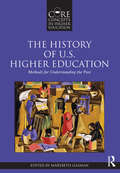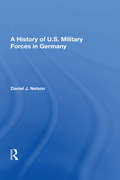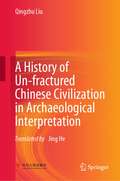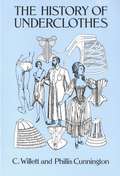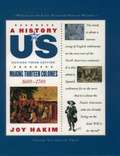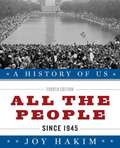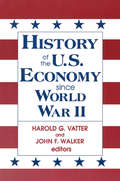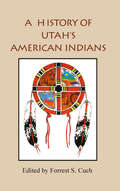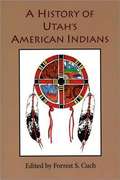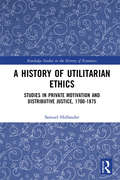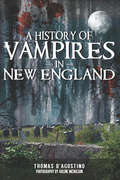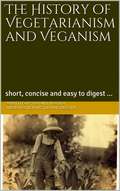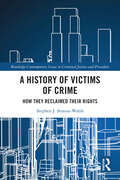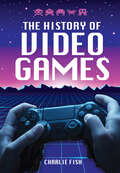- Table View
- List View
The History of U.S. Higher Education – Methods for Understanding the Past (Core Concepts in Higher Education)
by Marybeth GasmanThe first volume in the Core Concepts of Higher Education series, The History of U.S. Higher Education: Methods for Understanding the Past is a unique research methods textbook that provides students with an understanding of the processes that historians use when conducting their own research. Written primarily for graduate students in higher education programs, this book explores critical methodological issues in the history of American higher education, including race, class, gender, and sexuality. Chapters include: Reflective Exercises that combine theory and practice Research Method Tips Further Reading Suggestions. Leading historians and those at the forefront of new research explain how historical literature is discovered and written, and provide readers with the methodological approaches to conduct historical higher education research of their own.
A History Of U.s. Military Forces In Germany
by Daniel J. NelsonDiscussing why the U.S. will remain in the FRG for the foreseeable future, this book examines the U.S. military presence in Germany. It shows how that presence has affected the development of the political and diplomatic relationship between the two countries.
History Of The U. S. Volume 1 Beginnings to 1877
by Lorna C Mason William Jay Jacobs Robert P LudlumIn this history of the American people, we begin with the Native Americans and conclude with the Civil War and its aftermath. We show how the territory and people of the United States reflect an Indian, British, African, French, and Spanish heritage. We try to show the drama of the past, the agonies as well as the joys. We try to show the consequences of decisions made, and of decisions not made. Most of all, we try to make the past meaningful to you as you prepare yourself for life in the twenty-first century.
History of Ukraine - 2nd, Revised Edition
by Paul Robert MagocsiFirst published in 1996, A History of Ukraine quickly became the authoritative account of the evolution of Europe's second largest country. In this fully revised and expanded second edition, Paul Robert Magocsi examines recent developments in the country's history and uses new scholarship in order to expand our conception of the Ukrainian historical narrative.New chapters deal with the Crimean Khanate in the sixteenth and seventeenth centuries, and new research on the pre-historic Trypillians, the Italians of the Crimea and the Black Death, the Karaites, Ottoman and Crimean slavery, Soviet-era ethnic cleansing, and the Orange Revolution is incorporated. Magocsi has also thoroughly updated the many maps that appear throughout.Maintaining his depiction of the multicultural reality of past and present Ukraine, Magocsi has added new information on Ukraine's peoples and discusses Ukraine's diasporas. Comprehensive, innovative, and geared towards teaching, the second edition of A History of Ukraine is ideal for both teachers and students.
A History of Un-fractured Chinese Civilization in Archaeological Interpretation
by Qingzhu LiuThis book presents an archeological interpretation of the history of Chinese civilization. Tracing back from recent history to the distant past, it explores the breadth of Chinese civilization. Using archeological remains and cultural relics as starting points and approaching the cultural dimension from material perspectives, it presents a panoramic view of China’s civilizational continuity, together with its ideological and cultural characteristics. Featuring a wealth of illustrations (including photos of cultural relics and sites, archeological surveys, etc.) and texts written in easy-to-understand language, it offers an engaging read without sacrificing academic quality. The main components of “civilization” are addressed: capital archeology, mausoleum archeology, ritual wares and architecture archeology, as well as written language. The book offers a unique resource for archeology scholars and majors, as well as general readers who are interested in Chinese archeology and history.
The History of Underclothes
by C. Willett Cunnington PhiIlis Cunnington". . . thoroughness and most impressive scholarship . . . much entertaining detail and . . . pleasant humour." — The Times Literary Supplement (London)Underwear — practical garments with a utilitarian function or body coverings that serve an erotic purpose? As this fascinating and intelligently written study shows, the role played by underclothing over the last several centuries has been a varied one.In a well-documented, profusely illustrated volume combining impressive scholarship with an entertaining, often humorous style, two distinguished clothing historians consider undergarments worn by the English over the past 600 years. Beginning with the Middle Ages, the authors cover centuries of clothing history, including the Tudor period, the Restoration, the Victorian and Edwardian eras, and the twentieth century up to the eve of World War II. Drawing on extensive, research, the Cunningtons illuminate the role and function of underwear: it protected the wearer against the elements, supported costume shapes, served as an erotic stimulus, symbolized class distinctions, and fulfilled other social, sanitary, and economic functions. Enhancing the detailed, comprehensive text are more than 100 period illustrations and photographs depicting a laced-up bodice of the twelfth century, embroidered linen drawers of the sixteenth century, a hooped petticoat support in bentwood (c. 1750), footed long drawers (1795), nineteenth-century bustles, early nineteenth-century corsets for men, "Frillies for the Tiny Lady" (1939), and much more. A bibliography, appendix, and index complete a valuable reference work that will appeal to costume historians, sociologists, and other readers.
History Of The United States
by Thomas V. Dibacco Lorna C. Mason Christian G. Appy Houghton Mifflin Company StaffHistory of the United States was designed with three goals in mind:<P> 1. To provide thorough coverage of American history from earliest times to the present, with special emphasis on the twentieth century.<P> 2. To identify the major themes in American history and explain their importance at each stage in the development of the United States.<P> 3. To convey a sense of the breadth of experiences and influences that have shaped the United States.
A History of Urdu Literature
by Ali Jawad ZaidiThis work presents a compact survey of the rich and varied contribution of Urdu to the Indian literary mainstream through centuries of shared creative inspiration.
A History of US: Making Thirteen Colonies: 1600-1740 A History of US
by Joy Hakim<P>Recommended by the Common Core State Standards for English Language Arts and Literacy as an exemplary informational text. <P>All kinds of people are coming to America. If you're European, you come in search of freedom or riches. If you're African, you come in chains. And what about the Indians, what is happening to them? Soon with the influx of so many people, thirteen unique colonies are born, each with its own story. Meet Pocahontas and John Smith in Jamestown. Join William Penn and the Quakers in Pennsylvania. Sit with the judges at the Salem witch trials. Hike over the mountains with Daniel Boone. And let Ben Franklin give you some salty advice in his Poor Richard's Almanac in this remarkable journey through the dynamic creation of what one day becomes the United States.
A History of Us: All the People (Since 1945) (A History of Us #10)
by Joy HakimA History of US is a 10-volume, award-winning series about the birth and development of the United States as related by master storyteller Joy Hakim. All the People, the last volume in the series, covers US History from the end of World War II to the present. This updated fourth edition covers, for the first time, events that have taken place in the past 6 years, including the 2008 election of Barack Obama and the signficance of this election. All the People focuses on Civil Rights in the last half of the 20th Century and the beginning of the 21st, ensuring that readers will have a firm grasp of the groundbreaking nature and lasting importance of this movement. Throughout the book, which has been completely redesigned with a bold new look, Hakim portrays contemporary American life in a lively, engaging way. Readers will encounter fascinating stories about famous Americans (Joe McCarthy, Martin Luther King, Jr., Richard Nixon), historical events (the Vietnam War, the first man on the moon), and major cultural movements (1960s counterculture, feminism). Interspersed features provide further anecdotes about the characters that have shaped the last 65 years--for instance, one conjectures about what Alan Greenspan might hide in his briefcase; another discusses the life and times of Mark I, the world's first automatic computer. Sidebars, illustrations, definitions and quotes line the margins, providing illimitable sources of information and entertainment. About the Series: Master storyteller Joy Hakim has excited millions of young minds with the great drama of American history in her award-winning series A History of US. Recommended by the Common Core State Standards for English Language Arts and Literacy as an exemplary informational text, A History of US weaves together exciting stories that bring American history to life. Hailed by reviewers, historians, educators, and parents for its exciting, thought-provoking narrative, the books have been recognized as a break-through tool in teaching history and critical reading skills to young people. In ten books that span from Prehistory to the 21st century, young people will never think of American history as boring again.
History of US Economy Since World War II
by Harold G. Vatter John F. WalkerA collection of articles covering the economic history of the US over the last 50 years. It is selective in its coverage of important issues not often treated historically, such as the economics of medical care and the educational system.
A History of US, Volume A, Prehistory to 1800 (Concise Edition)
by Joy HakimBy special arrangement with the author and publisher, K12 is proud to offer a special four-volume Concise Edition of A HISTORY OF US, the award-winning and critically acclaimed series by Joy Hakim. The Concise Edition features the same lively, engaging, story-driven prose as the original series. These textbooks are fun to read! K12's Concise Edition is designed to meet the needs of busy home educators as well as schools and classrooms, where time constraints can make it difficult to read all ten volumes in the original edition. This book-Volume A, the first of four volumes in the Concise Edition-tells the story of America from prehistory to 1800, including the lives of early Native Americans, the settlement of the thirteen colonies, and the American Revolution. K12's Concise Edition of A HISTORY OF US features many color illustrations and photographs, all new maps, charts, and graphs, helpful collections of important primary sources, and a glossary and index in each volume. "For those who want an overview of American history," says Joy Hakim, "my friends at K12 have made choices and helped create this new four-volume version. I'm very pleased with what they've done." [This text is listed as an example that meets Common Core Standards in English language arts in grades 4-5 at http://www.corestandards.org.]
A History of US, Volume B: 1790 to 1877
by Joy HakimBy special arrangement with the author and publisher, K12 is proud to offer a special four-volume Concise Edition of A HISTORY OF US, the award-winning and critically acclaimed series by Joy Hakim. The Concise Edition features the same lively, engaging, story-driven prose as the original series. These textbooks are fun to read! K12's Concise Edition is designed to meet the needs of busy home educators as well as schools and classrooms, where time constraints can make it difficult to read all ten volumes in the original edition. This book-Volume A, the first of four volumes in the Concise Edition-tells the story of America from prehistory to 1800, including the lives of early Native Americans, the settlement of the thirteen colonies, and the American Revolution. K12's Concise Edition of A HISTORY OF US features many color illustrations and photographs, all new maps, charts, and graphs, helpful collections of important primary sources, and a glossary and index in each volume. "For those who want an overview of American history," says Joy Hakim, "my friends at K12 have made choices and helped create this new four-volume version. I'm very pleased with what they've done." This text is listed as an example that meets Common Core Standards in English language arts in grades 4-5 at http://www.corestandards.org.]
A History of US, Volume B: 1790 to 1877 (Concise Edition)
by Joy HakimThis second volume of the concise edition of A History of US retains the major stories from the original edition. The author shows how idealism, good sense, hard work, and thoughtless nastiness were brought out in the years that go from George Washington to Abraham Lincoln. This text is listed as an example that meets Common Core Standards in English language arts in grades 4-5 at http://www.corestandards.org.]
A History of Us, Volume C, 1865 to 1932 (Concise Edition)
by Joy HakimWhite the Civil War was being fought, and afterwards too, there was war in the West. It was the new settlers fighting the Indians, the buffalo, and nature for control of the land. This text is listed as an example that meets Common Core Standards in English language arts in grades 4-5 at http://www.corestandards.org.]
A History of US, Volume D: 1929 to Present
by Joy HakimThis text is listed as an example that meets Common Core Standards in English language arts in grades 4-5 at http://www.corestandards.org.]
A History of US, Volume D: 1929 to Present (Concise Edition)
by Joy HakimThis fourth book in the concise edition of A History of US takes us to a time--right now--when much of the world is struggling to achieve what we often take for granted: democracy. This text is listed as an example that meets Common Core Standards in English language arts in grades 4-5 at http://www.corestandards.org.]
History Of Utah's American Indians
by Forrest CuchThis book is a joint project of the Utah Division of Indian Affairs and the Utah State Historical Society. It is distributed to the book trade by Utah State University Press. The valleys, mountains, and deserts of Utah have been home to native peoples for thousands of years. Like peoples around the word, Utah's native inhabitants organized themselves in family units, groups, bands, clans, and tribes. Today, six Indian tribes in Utah are recognized as official entities. They include the Northwestern Shoshone, the Goshutes, the Paiutes, the Utes, the White Mesa or Southern Utes, and the Navajos (Dineh). Each tribe has its own government. Tribe members are citizens of Utah and the United States; however, lines of distinction both within the tribes and with the greater society at large have not always been clear. Migration, interaction, war, trade, intermarriage, common threats, and challenges have made relationships and affiliations more fluid than might be expected. In this volume, the editor and authors endeavor to write the history of Utah's first residents from an Indian perspective. An introductory chapter provides an overview of Utah's American Indians and a concluding chapter summarizes the issues and concerns of contemporary Indians and their leaders. Chapters on each of the six tribes look at origin stories, religion, politics, education, folkways, family life, social activities, economic issues, and important events. They provide an introduction to the rich heritage of Utah's native peoples. This book includes chapters by David Begay, Dennis Defa, Clifford Duncan, Ronald Holt, Nancy Maryboy, Robert McPherson, Mae Parry, Gary Tom, and Mary Jane Yazzie. Forrest Cuch was born and raised on the Uintah and Ouray Ute Indian Reservation in northeastern Utah. He graduated from Westminster College in 1973 with a bachelor of arts degree in behavioral sciences. He served as education director for the Ute Indian Tribe from 1973 to 1988. From 1988 to 1994 he was employed by the Wampanoag Tribe in Gay Head, Massachusetts, first as a planner and then as tribal administrator. Since October 1997 he has been director of the Utah Division of Indian Affairs.
A History of Utah's American Indians
by Forrest S. CuchThis book is a joint project of the Utah Division of Indian Affairs and the Utah State Historical Society. It is distributed to the book trade by Utah State University Press. The valleys, mountains, and deserts of Utah have been home to native peoples for thousands of years. Like peoples around the word, Utah's native inhabitants organized themselves in family units, groups, bands, clans, and tribes. Today, six Indian tribes in Utah are recognized as official entities. They include the Northwestern Shoshone, the Goshutes, the Paiutes, the Utes, the White Mesa or Southern Utes, and the Navajos (Dineh). Each tribe has its own government. Tribe members are citizens of Utah and the United States; however, lines of distinction both within the tribes and with the greater society at large have not always been clear. Migration, interaction, war, trade, intermarriage, common threats, and challenges have made relationships and affiliations more fluid than might be expected. In this volume, the editor and authors endeavor to write the history of Utah's first residents from an Indian perspective. An introductory chapter provides an overview of Utah's American Indians and a concluding chapter summarizes the issues and concerns of contemporary Indians and their leaders. Chapters on each of the six tribes look at origin stories, religion, politics, education, folkways, family life, social activities, economic issues, and important events. They provide an introduction to the rich heritage of Utah's native peoples. This book includes chapters by David Begay, Dennis Defa, Clifford Duncan, Ronald Holt, Nancy Maryboy, Robert McPherson, Mae Parry, Gary Tom, and Mary Jane Yazzie. Forrest Cuch was born and raised on the Uintah and Ouray Ute Indian Reservation in northeastern Utah. He graduated from Westminster College in 1973 with a bachelor of arts degree in behavioral sciences. He served as education director for the Ute Indian Tribe from 1973 to 1988. From 1988 to 1994 he was employed by the Wampanoag Tribe in Gay Head, Massachusetts, first as a planner and then as tribal administrator. Since October 1997 he has been director of the Utah Division of Indian Affairs.
A History of Utilitarian Ethics: Studies in Private Motivation and Distributive Justice, 1700-1875 (Routledge Studies in the History of Economics)
by Samuel HollanderIn this landmark volume, Samuel Hollander presents a fresh and compelling history of moral philosophy from Locke to John Stuart Mill, showing that a ‘moral sense’ can actually be considered compatible with utilitarianism. The book also explores the link between utilitarianism and distributive justice. Hollander engages in close textual exegesis of the works relating to individual authors, while never losing sight of the intellectual relationships between them. Tying together the greatest of the British moral philosophers, this volume reveals an unexpected unity of eighteenth and nineteenth century ethical doctrine at both the individual and social level. Essential reading for advanced students and researchers of the history of economic thought, political economy, history of ethics, history of political thought and intellectual history.
A History of Vampires in New England (Haunted America)
by Thomas D'AgostinoThe author of A Guide to Haunted New England lifts the coffin lid on the region&’s folklore and legends of the undead. New England is rich in history and mystery. Numerous sleepy little towns and farming communities distinguish the region&’s scenic tranquility. But not long ago, New Englanders lived in fear of spectral ghouls believed to rise from their graves and visit family members in the night to suck their lives away. Although the word &“vampire&” was never spoken, scores of families disinterred loved ones during the eighteenth and nineteenth centuries searching for telltale signs that one of them might be what is now referred to as the New England vampire. &“In his remarkable book . . . Thomas D&’Agostino details the longstanding belief among New Englanders that supernatural entities were responsible for the disease called consumption.&”—Crime Capsule Includes photos! Praise for A Guide to Haunted New England &“Fun, charming . . . includes not only locales with reported ghosts, but also sites with macabre (though not haunted) histories.&”—True Crime Librarian &“Anyone interested in exploring the haunted, macabre and abandoned throughout New England knows they can count on D&’Agostino to find out more about the site&’s history, past sightings and how to find them.&”—Mobile RVing
The History of Vegetarianism and Veganism: short, concise and easy to digest...
by Daniel HagenFor roughly ten generations, we have been living in an era of industrialisation. An era that keeps going non-stop. Humanity is, so to speak, in overdrive! This does also apply to our diets; meat has become a cheap mass-produced commodity and we eat sun-ripened papayas in the coldest winters. Common shrimps are caught in the Norther Sea, peeled in Morocco and then send back to Northern Germany where they are then sold and eaten as “freshly caught”. Meanwhile, there is more plastic floating around in the deep sea than maritime creatures. In a large part of the world, many humans are still suffering from malnutrition – in other parts of the globe, there has been a rapid increase in obesity, diabetes and the like. Considering this, one might think that a vegetarian and, in a wider sense, vegan approach to diets is a young phenomenon, that has sprung mainly from the wealthy, privileged classes of the First World. Though that is far from true!
A History of Victims of Crime: How they Reclaimed their Rights (Routledge Contemporary Issues in Criminal Justice and Procedure)
by Stephen J. Strauss-WalshThis book examines the evolution of the contemporary crime victim’s procedural place within modern Western societies. Taking the history of the Irish crime victim as a case study, the work charts the place of victims within criminal justice over time. This evolves from the expansive latitude that they had during the eighteenth century, to their major relegation to witness and informer in the nineteenth, and back to a more contemporary recapturing of some of their previous centrality. The book also studies what this has meant for the position of suspects and offenders as well as the population more generally. Therefore, some analysis is devoted to examining its impact on an offender’s right to fair trial and social forms. It is held that the modern crime victim has transcended its position of marginality. This happened not only in law, but as the consequence of the victim’s new role as a key sociopolitical stakeholder. This work flags the importance of victim rights conferrals, and the social transformations that engendered such trends. In this way victim re-emergence is evidenced as being not just a legal change, but a consequence of several more recent sociocultural transformations in our societies. The book will be of interest to researchers, academics, and policy makers in criminal law, human rights law, criminology, and legal history.
A History of Victoria
by Geoffrey BlaineyA History of Victoria is a lively account of the people, places and events that have shaped Victoria, from the arrival of the first Aboriginal peoples through to the present day. In his inimitable style, Geoffrey Blainey considers Victoria's transformation from rural state to urban society. He speculates on the contrasts between Melbourne and Sydney, and describes formative events in Victoria's history, including the exploits of Ned Kelly, the rise of Australian Football and the Olympics of 1956. Melbourne's latest population boom, sprawling suburbs and expanding ethnic communities are explored. Blainey also casts light on Victoria's recent political history. This edition features sections on the Black Saturday bushfires of 2009, the end of the drought and the controversy surrounding the Wonthaggi desalination plant. New illustrations, photographs and maps enrich the narrative. Written by one of Australia's leading historians, this book offers remarkable insight into Victoria's unique position within Australian history.
The History of Video Games
by Charlie FishThis book is a potted history of video games, telling all the rollercoaster stories of this fascinating young industry that’s now twice as big globally than the film and music industries combined. Each chapter explores the history of video games through a different lens, giving a uniquely well-rounded overview. Packed with pictures and stats, this book is for video gamers nostalgic for the good old days of gaming, and young gamers curious about how it all began. If you’ve ever enjoyed a video game, or you just want to see what all the fuss is about, this book is for you. There are stories about the experimental games of the 1950s and 1960s; the advent of home gaming in the 1970s; the explosion – and implosion – of arcade gaming in the 1980s; the console wars of the 1990s; the growth of online and mobile games in the 2000s; and we get right up to date with the 2010s, including such cultural phenomena as twitch.tv, the Gamergate scandal, and Fortnite. But rather than telling the whole story from beginning to end, each chapter covers the history of video games from a different angle: platforms and technology, people and personalities, companies and capitalism, gender and representation, culture, community, and finally the games themselves.
